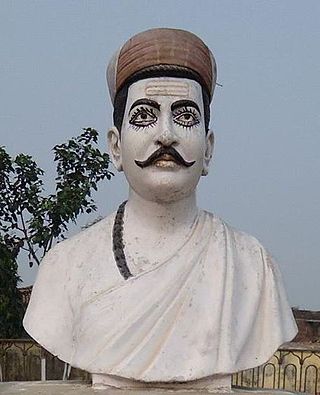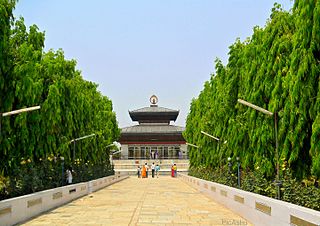Related Research Articles

Vidyapati, also known by the sobriquet Maithil Kavi Kokil, was a Maithili and Sanskrit polymath-poet-saint, playwright, composer, biographer, philosopher, law-theorist, writer, courtier and royal priest. He was a devotee of Shiva, but also wrote love songs and devotional Vaishnava songs. He had knowledge of, and composed works in Sanskrit, Prakrit, Apabhramsha and Maithili.

Maithils, also known as Maithili people, are an Indo-Aryan ethno-linguistic group from the Indian subcontinent, who speak the Maithili language as their native language. They inhabit the Mithila region, which comprises Northern and Eastern Bihar and Northeastern Jharkhand in India and some adjoining districts of Nepal constituting Madhesh Province in addition to some terai districts of Bagmati and Koshi Provinces.
The Darbhanga Raj, also known as Raj Darbhanga and the Khandwala dynasty, was a Maithil Brahmin dynasty and the rulers of territories, not all contiguous, that were part of the Mithila region, now divided between India and Nepal.

Mithila, also known as Tirhut, Tirabhukti and Mithilanchal, is a geographical and cultural region of the Indian subcontinent bounded by the Mahananda River in the east, the Ganges in the south, the Gandaki River in the west and by the foothills of the Himalayas in the north. It comprises certain parts of Bihar and Jharkhand of India and adjoining districts of the Koshi Province, Bagmati Pradesh and Madhesh Province of Nepal. The native language in Mithila is Maithili, and its speakers are referred to as Maithils.
Mithila is a geographical and cultural region located in the Indian subcontinent. The native language is known as Maithili and its speakers are referred to as Maithils. The majority of the Mithila region falls within modern-day India, more specifically in the state of Bihar. Mithila is bounded in the north by the Himalayas, and in the south, west and east by the Ganges, Gandaki and Mahananda respectively. It extends into the southeastern Terai of Nepal. This region was also called Tirabhukti, the ancient name of Tirhut.

Maithil Brahmins are the Indo-Aryan Hindu Brahmin community originating from the Mithila region of the Indian subcontinent that comprises Madhesh Province of Nepal and the Tirhut, Darbhanga, Kosi, Purnia, Munger, Bhagalpur and Santhal Pargana divisions of India. They are one of the five Pancha-Gauda Brahmin communities. The main language spoken by Maithil Brahmins is Maithili.
Surendra Jha 'Suman', also referred to as 'Suman Ji' or Acharya Surendra Jha 'Suman', was a Maithili poet, writer, publisher, editor and elected member of legislative assembly and parliament. He is also known for his role as publisher, editor, journalist, social and cultural reformer and promoter of Mithila culture. He authored about forty books in Maithili and was also the Editor of various publications and books in Maithili, Sanskrit and Hindi. He served the Governing Bodies of various literary and academic institutions in different capacities in his State. He was also the recipient of Sahitya Akademy Award in 1971 for Payaswini and in 1995 for Translation Rabindra Natakavali Vol. I. He was born in a village known as Ballipur in the Samastipur district of Bihar.
The Gandhavariya are a Rajput clan based in northern Bihar. They are descendants of King Vikramaditya of Malwa. In past they ruled over parts of Madhepura district and Saharsa district during medieval times after the decline of the Oiniwar Dynasty.
Dharmasvamin was a Tibetan monk and pilgrim who travelled to India between 1234 and 1236. His biography by Upasaka Chos-dar provides an eyewitness account of the times.
Simraungadh, Simraongarh or Simroungarh is a municipality situated in Bara district of Nepal.
Harisimhadeva was a King of the Karnat dynasty who ruled the Mithila region of modern-day parts of North Bihar in India and South Nepal.
The Oiniwar dynasty, or Oiṇīvāra dynasty also known as the Sugauna dynasty, was a Maithil ruling dynasty of territories that form part of the Mithila region of the Indian subcontinent. They governed the area between 1325 and 1526, being preceded by the Karnat dynasty. Following the demise of the dynasty, emerged the dynasty of the Raj Darbhanga. One of the Oiniwar Dynasty's most notable rulers was Shivasimha who was known for his patronisation of the art as well as leading military campaigns against neighbouring polities.

Nanyadeva was the founder of the Karnat dynasty of Mithila. He established his capital in Simraungadh and ruled the greater Mithila region for 50 years. He is known for his patronage of scholars. He has been described as belonging to the Karnat Kshatriya Kula and began to rule Mithila from the citadel of Simraungadh which was situated on the modern India-Nepal border, in 1097 CE. Various inscriptions and land grants belonging to Nanyadeva have been found within the region to testify to his reign.

The Karnats of Mithila or Karnata dynasty was a dynasty established in 1097 CE by Nanyadeva. The dynasty had its main stronghold in the citadel of Simraungadh which was situated on the Bihar-Nepal border with excavations showing that parts of the fort were situated in what is now Indian territory while the rest falls within what is now Nepalese territory. The city of Darbhanga also became the second capital during the reign of Gangadeva. The kingdom controlled the areas we today know as Tirhut or Mithila in the Bihar state of India and Nepal.
Gangadeva was the second ruler of the Karnat dynasty of Mithila. He succeeded his father Nanyadeva as king in 1147 and ruled until 1187.
Caṇḍeśvara Thakkura was a Maithili-language political theorist and warrior during the 14th century. He served as minister for peace and war and chief judge in the court of Harisimhadeva who was the last King of the Karnat dynasty of Mithila. This dynasty ruled parts of Southern Nepal and modern-day north Bihar in India. His family had their origins in the village of Bisfi in modern day Madhubani district, Bihar.
Narasimhadeva was the third King of the Karnat dynasty of Mithila. Most scholars agree that he came into power around 1174 CE and succeeded his predecessor, Gangadeva.
Malladeva was the son of King Nanyadeva from the Karnat dynasty, and a prince of Mithila. According to some scholars, Malladeva has been referred to as the "forgotten King of Mithila" as most records and traditions mention that his brother Gangadeva succeeded his father as ruler of the dynasty. Nevertheless, Malladeva seems to have founded his own stronghold in the village of Bheet-Bhagwanpur in Darbhanga in modern-day Bihar, India. An inscription found in the village reads: "Om Shree Malladevasya" and many Karnat-era sculptures have been found in the area.
Shiva Simha Singh was the King of Oiniwar dynasty in Mithila. He is also known as Sivasimha. He was also referred to as Rūpanārāyana. He was the King of Mithila. He declared himself independent and stopped paying taxes to Jaunpur Sultanate. Due to his decision to challenge the authority of the Sharqi empire, Ibrahim Shah Sharqi attacked Mithila but was defeated.

Alauddin Khalji's invasion of Mithila was a military campaign conducted by Alauddin Khalji of the Delhi Sultanate against the Karnat dynasty of Mithila, led by Shaktisimharadeva, in 1297-98 C.E in present-day Northern Bihar.
References
- ↑ CPN Sinha (1970). "Decline of the Karnatas of Mithila". Proceedings of the Indian History Congress. 32: 79–84. JSTOR 44141053.
- ↑ Mishra, Vijaykanta (1979). Cultural Heritage of Mithila. Mithila Prakasana. p. 58. Retrieved 5 August 2020.
- ↑ Choudhary, Radhakrishna (1970). History of Muslim rule in Tirhut, 1206-1765, A.D. Chowkhamba Sanskrit Series Office. p. 19.